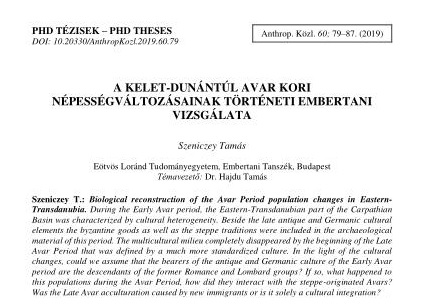Biological reconstruction of the Avar Period population changes in Eastern-Transdanubia
Abstract
During the Early Avar period, the Eastern-Transdanubian part of the Carpathian Basin was characterized by cultural heterogeneity. Beside the late antique and Germanic cultural elements the byzantine goods as well as the steppe traditions were included in the archaeological material of this period. The multicultural milieu completely disappeared by the beginning of the Late Avar Period that was defined by a much more standardized culture. In the light of the cultural changes, could we assume that the bearers of the antique and Germanic culture of the Early Avar period are the descendants of the former Romance and Lombard groups? If so, what happened to this populations during the Avar Period, how did they interact with the steppe-originated Avars? Was the Late Avar acculturation caused by new immigrants or is it solely a cultural integration?
Based on the results of my dissertation, the continuity of the late antique and Germanic groups to the Early Avar period has been proved. The cultural influences and relations of these local populations contributed to the emergence of the Early Avar material culture of Eastern-Transdanubia. The Early Avar period males of other regions had little biological impact on the Eastern-Transdanubian population, however females migrated here to a greater extent. The sex-specific migration rate resulted that the anthropological traits of the local males persisted even through the Late Avar period, while the continuity of the females localised to Baranya-county.
During the Late Avar period new populations had arrived to Eastern-Transdanubia and occupied mostly the present territories of Tolna- and Fejér-counties. As far as Baranya-county is concerned, the Late Avar period population was formed on the basis of Romance, Germanic and Early Avar period population. The new inhabitants of Eastern-Transdanubia had biological relations with populations living in the Danube-Tisza Interfluve and along the Tisza. Since these regions cover a relatively large geographic area, further systematic comparative studies are necessary to decipher the origin of these populations. Considering that there were similarities between the locally formed Late Avar period populations of Eastern-Transdanubia and the new immigrants, their biological integration could happen rapidly. From a demographic point of view, it is not possible to establish a causal relationship between the new population and the onset of the Late Avar period. Therefore, the cultural transition could have rather been the result of a cultural integration process.
References
Darroch, J.N., Mosimann, J.E. (1985): Canonical and principal components of shape. Biometrika 72(2): 241–252. DOI: https://doi.org/10.2307/2336077
Éry, K. (1982): Újabb összehasonlító statisztikai vizsgálatok a Kárpát-medence 6–12. századi népességeinek embertanához. VMMK, 16: 35–86.
Fóthi, E. (1984). A Kárpát-medence avar korának összehasonlító embertani vizsgálata. MFMÉ, 85: 483–501.
Kiss, A. (1992): Germanen im awarenzeitlichen Karpatenbecken. Awarenforschungen, 1: 35–134.
Martin, R., Saller, K. (1957): Lehrbuch der Anthropologie. Bd 1. Gustav Fischer Verlag, Stuttgart.
Pap, I., Fóthi, E., Józsa, L., Bernert, Zs., Hajdu, T., Molnár, E., Bereczki, Zs., Lovász, G., Pálfi, Gy. (2009): Történeti embertani protokoll – A régészeti feltárások embertani anyagainak kezelésére, alapszintű feldolgozására és elsődleges tudományos vizsgálatára. Anthropologiai Közlemények, 50: 105–123.
Pohl, W. (1998): Gepiden. Historisches. In: Hoops, J (Ed.) Reallexikon der Germanischen Altertumskunde 11. pp. 118–131.
Pohl, W. (2002): Die Awaren: ein Steppenvolk im Mitteleuropa. Beck V., München. pp. 567–822.
Relethford, J.H., Blangero, J. (1990): Detection of differential gene flow from patterns of quantitative variation. Human Biology, 62: 5–25.
Vida, T. (2003): A korai és közép avar kor. In: Visy, Zs. (Szerk.) Magyar Régészet az ezredfordulón. Nemzeti Kulturális Örökség Minisztériuma, Teleki László Alapítvány, Budapest. pp. 302–308.
Vida, T. (2008): Conflict and coexistence: the local population of the Carpathian Basin under Avar rule (sixth to seventh century). In: Curta, F. (Ed.) The other Europe in the Middle Ages. Brill, Leiden – Boston. pp. 13–46.
Williams-Blangero, S., Blangero, J. (1989): Anthropometric variation and the genetic structure of the Jirels of Nepal. Human Biology, 61: 1–12.




